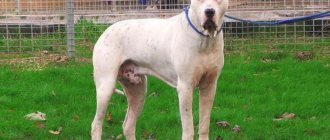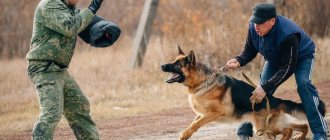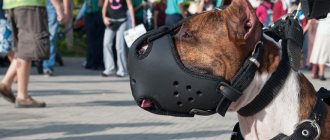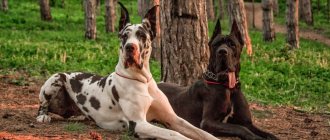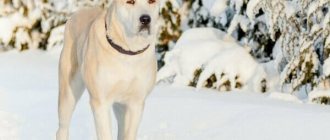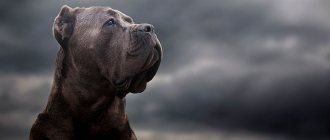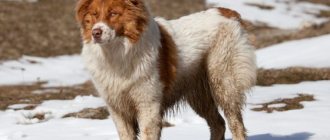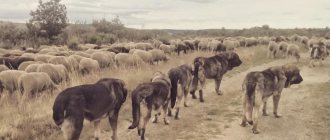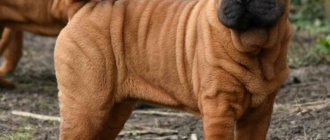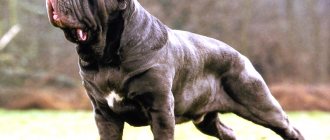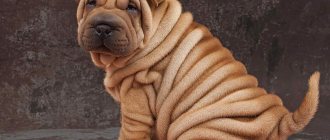Description and features
historical or documentary sources that would accurately confirm the history of the appearance of the Bully Kutta breed . Therefore, breeders can only speculate as to its origin. According to the most common version, the first owners of this dog were Persians. They used it for guard purposes.
An outsider could not approach the area guarded by a formidable beast. He was very strong and courageous, so he inspired fear and sometimes horror in potential enemies.
And the ancient representative of the breed helped the Persians in battle. They valued him for his speed, endurance and agility. The descendants of such dogs are very different from them. Breeders have worked for a long time to correct the aggressive traits of their character, thereby making such dogs more tame and controllable. Fortunately, they succeeded.
After Great Britain made India its colony, representatives of the breed in question began to be crossed with mastiffs and bull terriers. As a result of this breeding, a new type of dog was born. He has not lost his former power, but has become more contactable.
Interesting fact! From one of the eastern dialects, “bulli kutta” is translated as “wrinkled dog.” The animal received this name for a reason. The fact is that in the area of his neck and mouth there are sagging folds of skin, making him look like an accordion.
This is a very brave and strong animal. He doesn't lack courage. Due to the presence of such character traits, he is still exploited in battles. Unscrupulous breeders sell the largest and meanest puppies from the litter to the organizers of such events. Those, in turn, train them on people and animals, shaping the development of aggressive character traits.
This huge dog also shows ferocity when hunting. It is used for catching large game. The animal not only searches for prey by following the trail, it attacks it and can even kill it. By comparison, most hunting dogs never kill game, they find it or, at most, restrain it until the hunter arrives.
The main purpose of such a dog is to protect its owners and their estates. He bravely and vigilantly “patrolls” the territory in search of something suspicious. Yes, this dog can harm a person whom he suspects of evil intentions. That is why it is extremely important to pay special attention to her early education.
Briefly about the history of the development of bulli kutta
Bully Kutta (eng. bully - heavily wrinkled, kutta - dog) is an indigenous breed of India and Pakistan, which is distinguished by its strong constitution and endurance. Today you can hear various variations of the name of this breed:
- Pakistani Mastiff;
- Indian Mastiff;
- Sindha Mastiff;
- Mastiff Alangu.
Literally, “bulli kutta” means “heavily wrinkled dog.”
In Pakistan, this breed name is correctly pronounced "bully kuttah".
The history of the origin of the breed is vague, as there is no documentary evidence. Today, experts name several versions. The most plausible theory is that the breed originated during British colonial rule in Indo-Pakistan. British colonists, having captured Indo-Pakistan, brought with them pets of European breeds: mastiffs, bull terriers, hounds and others, and crossed them with local dogs. The result was Bulli Kutta. Dogs were used for military, security and hunting purposes.
Modern history of the development of the breed
Today, representatives of the Bully Kutta are distributed only in Pakistan and India. Due to the high aggressiveness that is inherent in this breed, pets are bred to participate in dog fights, as well as for protection. Only a few Pakistani Mastiffs have been imported to the European continent.
Even despite its fairly high prevalence in its homeland, the dog is not recognized by any canine organization. But it is known that The Kennel Club of UK (English Kennel Club) is interested in breeding this breed, therefore it is developing a breed standard, and also provides support to Pakistani breeders in its official recognition.
Breed standard
Let's start with the main thing. At the international canine level, the Bully Kutta dog is not standardized. Its parameters are still being carefully studied. This complexity is associated with the long history of formation and selection of the breed.
However, such a dog has unique exterior parameters. It is very large, growing up to 85-90 cm in height. It can weigh from 70 to 83 kg. Sometimes there are overgrown individuals. Their body weight is 90-95 kg.
The Pakistani Mastiff is well built and harmonious. He has a rectangular wide back. The stomach is sunken. The ribs on its lateral parts should be palpated and visible. If they are not visible, then the dog is clearly overfed.
Wide paw set. They are very long and slender. The pads are massive and hard. The peculiarity of the breed is the ability to maintain stability even on slippery surfaces. This is probably due to the hard pads of the feet. It also has long dark claws at the tips of its paws. The animal must grind them down, as the claws grow quickly.
He has strong thigh muscles, allowing him to quickly push off the ground to run or jump. The tail is thin, hangs evenly or may curl. The lower back is clearly visible, it is slightly convex. The neck is medium in length, quite thick.
The head of the Pakistani Mastiff is very large. Along its edges are poorly structured ears that should be cropped at 3 months. This is due to the fights in which the dog participates. But, if the owner of such a pet does not plan to register it for participation in such events, it is not necessary to crop its ears.
In this case, they will be medium in thickness, V-shaped in shape. The dog has fleshy, moist lips with pink gums. The jaw is very strong. She has a complete set of teeth. The nose is large, as are the eyes. The iris is most often brown or black.
Bulli kutta in the photo is depicted as strong, purposeful and interested. With his entire appearance he radiates power. Without a doubt, this is one of the strongest dogs. This massive dog cannot be called graceful and elegant. He treads rather heavily on the ground, his step lacks lightness and grace. Nevertheless, courage and strength emanate from him.
The Pakistani Mastiff has a short, bright coat. Can be any color: black, reddish-red, brown, etc. But the most common shade is pure white. The dog's fur is soft and pleasant to the touch.
Description of the breed
The Bully Cutta is not only a large, but also a beautiful dog with a well- developed chest, muscular neck and powerful skeleton. It has a huge head and a large, long snout with a strong set of teeth that form a scissor bite. Round, small ears are carried high, pigmentation is allowed on the nose.
Excess skin, especially under the chin and around the neck , is a distinctive feature of the breed and determines its name.
"Kutta" means dog, "bulli" means wrinkled.
The dog's lips hang freely, they are constantly moist due to a significant amount of saliva.
The Bully Kutta has long, slender legs and strong joints; The paws are wide and round, with hard pads. With a soft, swaying step and graceful gait, the dog resembles a lion in movement.
The tail is long, gradually tapering, lowered at rest and should not lie on the back when excited.
The Bully Cutta has a two-layer, short and coarse coat, the predominant color is white, but there are dogs of black, fawn, red, brindle and merle, as well as white and brown, black and white. There may be options with small spots, similar to a polka dot dress.
It's hard to imagine a larger dog - they look very impressive:
- height at the withers is from 76 to 112 cm, and weight is from 68 to 90 kg for males;
- height from 71 to 91 cm and weight from 59 to 68 kg in females.
Depending on its habitat, the breed has several names. The most common ones are:
- Indian Mastiff;
- Pakistani Mastiff;
- bulli kutta;
- alangu mastiff;
- Pakistani Bully;
- Indian Bully.
But regardless of the name, the Bully Kutta is always a mastiff of enormous, even frightening size, an impressive physique with a strong, menacing voice.
Character
Bully Cutta is one of the most difficult breeds to train. Its representatives can be friendly and aggressive at the same time. The restless disposition of such a dog is associated with his fighting past. In addition, he was exploited for bloodthirsty hunting. Of course, this could not but affect his character.
The basic advantage of a dog is the complete absence of fear. She is very brave, purposeful and responsible. Remains vigilant in any situation. She can be careful, especially in extreme situations.
He becomes strongly attached to the human teacher. Sincerely loves him. Learns respect from childhood. He can behave excessively cocky if he doesn’t please him in some way, for example, he forces him to study or scolds him. Capable of attack. Therefore, most dog experts agree that the Pakistani mastiff is mentally unstable, and therefore should not be kept by people as a pet. Is it so?
On the one hand, this animal is extremely intolerant of strangers, especially persistent and unfriendly ones. He barks loudly at them, and if they decide to cross his territory, he will certainly attack. On the other hand, any dog of the fighting breed is prone to such behavior, therefore, they are too biased towards the Bully Cutta.
Important ! Only young representatives of the breed are prone to overly energetic and aggressive behavior. More mature individuals are calm, passive, but also observant and cautious, as they were in their youth.
Some veterinarians call Pakistani Mastiffs bully dogs. This is true. Representatives of this breed can indeed behave destructively, especially at an early age. That is why they need to start training as early as possible.
In most cases, this dog behaves too impulsively. He can run around the area without stopping and bark at people, thus warning them of his possible attack. Capable of even challenging the owner. Too self-confident and prone to dominant behavior. These animal character traits need to be corrected.
The reader may now have a false idea of the bully cutta as an inadequate and uncontrollable dog. In fact, even she is not without merit. The main advantages of a representative of this breed compared to others:
- Courage and bravery.
- Fearlessness.
- Determination.
- Strong attachment to the owner.
- Excellent mental abilities.
Nature certainly did not deprive the dog of intelligence. Despite laziness and obstinacy, he very quickly remembers the commands that his owner teaches him and tries to carry them out. As a guard and bodyguard, the Pakistani Mastiff is unrivaled.
Worth considering! Bulli Kutta is not suitable for families with small children. He cannot get along with someone who is weaker than him physically and mentally. Moreover, it can be very jealous of its owner towards his child.
Character of the breed
For the Pakistani Mastiff, the main character traits are: loyalty, courage, and enormous willpower. However, managing such a dog is quite problematic. Therefore, training must begin from early childhood. You need to understand that if a dog displays its basic protective properties, irreparable harm may be caused to a person. Not every dog handler will undertake training such a dog. Exercising on your own can be dangerous. During training, you can develop more qualities in your dog as a bodyguard or property guard.
The Pakistani Mastiff is characterized by high affection for its owner.
To conduct a dialogue on equal terms, the owner must have much greater power than the dog. The main purpose of a dog of this breed is protection, so it is sensitive to extraneous noises and is capable of showing aggression towards strangers.
Bully Cutta is a dog that can stand up for its owner or his family members right on the street, so owners need to be careful not to get into an unpleasant situation. After all, much of what happens in an urban environment may seem dangerous to a dog.
He behaves kindly in the family, but keeping such a dog in an urban environment is wrong. Even her size suggests that she needs a lot of space. The physical activity required does not allow the Pakistani Mastiff to live comfortably in the city.
If there are other animals in the house, she most often treats them neutrally. But it is worth making sure that they do not play together, because the mastiff can even accidentally injure other pets. The dog has endurance, patience, and calmness. But it can be extremely difficult to predict a change in her mood.
Nutrition and care
The Pakistani Mastiff (Bully Kutta) does not require much attention in basic grooming. His coat is short, so it is enough to brush it once a week to remove dead hair. In addition, brushing procedures create a massage effect, which increases blood circulation. As a result, the coat will always be shiny and healthy looking. It is not customary to bathe a Pakistani Mastiff. You can wipe the face and chest with a damp towel to relieve the effects of drooling.
The owner of such a dog will have more worries about walking it. The Pakistani Mastiff must have a high level of exercise. If you still decide to keep him in an apartment, then you should find a park away from people so that you can train with the dog and take long walks there.
The dog must have its own place organized. An old mattress will do as bedding.
Not everyone can afford to keep a Pakistani mastiff. After all, this huge dog needs to be fed very well. Moreover, a large share of her diet comes from expensive protein products: natural meat, sea fish, kefir, cottage cheese and boiled eggs.
You can only give your dog food once a day. But maintaining such an interval, seeing when other household members are eating, can be problematic for the dog. It is for this reason that it is recommended to feed the Pakistani Mastiff in the morning and evening after walks. The Mastiff must drink a lot. You should always keep clean water in a bowl so that he can quench his thirst.
If you want to have such a dog, it is best to organize its residence outside the city. This will not only reduce certain risks, but will allow the Pakistani Mastiff to live more comfortably.
Maintenance and care
It is extremely difficult to get along with a huge fighting dog in a cramped apartment. She needs a lot of space to use her best qualities - speed, agility, maneuverability. The strength of a physically resilient dog must be maintained through sports. She should practice at least 1 hour a day. Therefore, if you are not sure that you can devote such time to her every day, it is better not to get such a dog at all.
It should be noted that Pakistani mastiffs who do not regularly engage in sports are more intolerant and angry. They definitely need loads! You can run cross-country or sprint with such dogs, throw them a ball and ask them to bring it, teach them to jump over a barrier, etc.
Even if you live in a country house, you will have to walk a representative of the breed twice a day. Be sure to put a muzzle on him. You can't let him off the leash. This is due to the law on walking aggressive dogs. Also, never ask anyone or acquaintances or friends to hold the leash while you are distracted by something.
If the mastiff realizes that its owner has lost his vigilance, he can take advantage of the situation and rush forward. It is very easy to care for. The requirements are standard. Firstly, the Bully Kutta should be combed so that its coat is renewed faster. This is done every week, and in the summer, more precisely during the molting season, every day.
Secondly, his teeth and fangs need to be cleaned of plaque so that tartar does not form on them. And thirdly, it should be washed with water every day. Bathing such a large dog is not easy. It is advisable to do this outdoors using a hose and shampoo. But his ears are washed separately and carefully. No water should get into them!
Reviews of the Pakistani Mastiff
Bully Kutta or otherwise Pakistani Mastiff is a very large and aggressive breed of dog.
In its homeland of Pakistan, it is used in dog fighting. Bully Cutts have a terrible reputation: they are bloodthirsty, do not get along with other animals and can kill them in fights for territory. Such dogs should not be owned if there are children in the house. But nevertheless, they are very loyal and unsurpassed guards. This is another name for this breed. The combination of words comes from Hindi and translated means “wrinkled dog.” There are several other variants of the name - Singh Mastiff, Indian or Alang Mastiff.
This breed most likely originated from the aboriginal dogs of the southern regions of India, which were used as guard dogs. During the colonization of the Indo-Pakistani territory, the British crossed it with the imported English mastiffs and bull terriers to enhance its fighting qualities.
From ancient sources we know that dogs similar to the one described were seen back in the 5th century BC in Greece, when the army of the Persian king Xerxes the First passed through the country. Fierce dogs of enormous stature guarded food and other convoys. It is also known that Pakistani mastiffs were kept by Indian royal families for games and hunting, however, later their use was reduced to guard duty.
Rare owners still characterize the dog as a reserved, not particularly active animal, but little inclined to obedience. It is believed that the Pakistani Mastiff is characterized by great devotion to its owner (but, as a rule, only one), excellent guarding qualities, courage and willpower.
It must be remembered that the animal is inclined to show aggression towards someone whom it considers an enemy. If you take into account the strength of the Pakistani mastiff, you can imagine what harm he can cause to the health of a person whom he simply “does not like.” This point becomes especially relevant if the owner is walking the dog on city streets.
We invite you to familiarize yourself with: Care and education of the English Mastiff *photos and videos* Reviews of dog lovers
Owners would not recommend keeping a dog of this breed together with other pets - not because the dog always shows excessive aggressiveness towards them, but simply because the animal, due to its size, can injure them unnoticed.
Nutrition
Massive and large dogs need to eat a lot to stay strong. They require a lot of fats, carbohydrates and protein. The last element is the most important; in the body of a living creature it performs a construction function. A bully cutta puppy should eat meat and drink milk every day.
These are two important products, the use of which will lay the foundation of the future immune system in his body. In addition, feeding a young dog protein food with microelements will allow her to quickly gain the necessary weight.
In addition to milk and meat, he should be fed cereals and fruits. As the Pakistani Mastiff gets older, he is switched to dry food. The daily norm for him is 700-800 grams, no less. List of foods prohibited for domestic dogs:
- Smoked meats.
- Salo.
- Bone fatty fish.
- Marmalade, cream cake, chocolate.
- Lollipops.
- Delicious baked goods.
- Spicy dishes.
The health of your pet depends to a large extent on proper nutrition.
Recommendations from dog handlers
A dog of the Pakistani Mastiff breed needs a strong hand, so it is not recommended for novice breeders and people with weak psyches to purchase it. It is advisable that the dog's owner be a person with good endurance and physically strong.
We suggest you read: The longest-living aquarium fish
It is recommended to start training dogs of this breed from an early age. But not on your own. And not every dog handler can cope with such a dog, so it is better to select in advance an experienced specialist who knows all the nuances of mastiff training. Only he will help turn a dog of a dangerous breed into a reliable guard and loyal friend, as well as into a calm and balanced dog.
Reproduction and lifespan
It is extremely rare for Bulli Kutta to live to be 12 years old. On average, they live no more than 8-9 years. If a dog is well and properly cared for, it will serve its owners faithfully. Large dogs are bred when they are at least 2 years old.
Previously, it was impossible. It is also not recommended to breed mature dogs over 7 years old. The best time for mating is the 3rd day from the day the female starts estrus. If she happens to a male during this period, she will probably become pregnant.
Price
There are very few purebred representatives of this ancient breed in Russia. In the vast majority of cases, breeders pass off bully mixes as purebred mastiffs, and they ask for a decent amount of money for them, from 50 thousand rubles.
If you want to purchase an absolutely healthy and “correct” dog of this breed in all respects, we advise you to go for it to its homeland, that is, to Pakistan. There they will ask for at least 30-40 thousand for it. The price of bulli kutta in other countries of the world can reach 60 thousand rubles.
Origin story
Due to the lack of any documentation, the history of the Bully Cutta breed consists mainly of theories and speculation. Pakistani mastiffs appeared in ancient times. They were used by the Persian army for security and military purposes. In Europe they were first noticed in Greece, where they came with the army of Xerxes I in the 500s BC. Mastiffs were "improved" during the British Empire in India. The dogs were crossed with the English bull terrier, English mastiff, and hunting dogs. At that time, large local dogs were used to guard and hunt large animals (tiger, bear, cheetah, buffalo, lion).
The name of the breed, Bully Kutta, translated from Hindi means “heavily wrinkled dog.”
Today, bulli kutta is found mainly in the Sindh and Punjab region (a geopolitical and cultural region that includes parts of East Pakistan and Northern India). In Pakistan, most BKs are used as fighting dogs, in India - for protection. Kutta are famous for their endurance, strength and courage.
In June 2021, at a meeting of the WKU Standards Commission, Faisel Dogar presented information on the indigenous breed - the Pakistani Mastiff (Buli Kuta). The commission accepted the documents provided for further study and drawing up a plan for working with the breed group.
Education and training
The main attention in raising such a serious dog must be paid to correcting its behavior pattern when interacting with others. It is important to teach him to communicate adequately with members of the household. Remember, a pet dog should under no circumstances be angry with anyone in his household.
From an early age, he learns to understand which people are included in his pack and which are strangers. He may be prejudiced and intolerant towards the latter, but only if his owner is not nearby.
The owner of a serious fighting dog should be guided by these simple rules for raising it:
- Be present while the Bully Cutta puppy eats. At this moment you need to pet him and talk to him. It would also be a good idea to touch his food and take it in your palm, and then offer the animal to eat from your hand. This way he will understand that it is not he who controls the food, but you, and therefore will be imbued with respect for you.
- If your dog bullies another pet, raise your voice at him. And if he tries to attack him, lightly slap him on the lower back, and then send him to the enclosure. The representative of the breed does not like loneliness and next time, in order to avoid it, he will be more tolerant.
- Don't let him fool around, ever. In order for the Pakistani Mastiff to be well managed, it should always be kept under control.
- Practice walking calmly together. The dog should not pull on the leash, break free, or lunge at everyone around him. He should silently walk next to his owner, trust him and not react to strangers. To do this, tighten the leash and practice walking together in the yard, stopping periodically.
Praise the Bully Kutta when he is aggressive towards strangers who come close to your home area. Reward him with delicious food. He should notify the owner of the arrival of a guest by barking. But if he tries to attack him, this should be condemned.
If you yourself let a guest into the house, drive the dog away; it can only come at your command. At the first sign of aggression towards a guest, lock him in an enclosure and do not let him out until he leaves.
Of course, unscrupulous owners can deliberately train Pakistani mastiffs to kill people and animals, turning them into “cold weapons.” Under no circumstances should you do this. Remember, a domestic dog, even a fighting breed, also needs affection and love. So don’t deny Bully Kutta attention and care.
Training
Being the owner of a powerful and formidable Pakistani Mastiff is an extremely big responsibility. A dog “from the cradle” needs education and professional training with an experienced dog handler who knows the breed. Only a strong and strong-willed person with a great sense of responsibility will be able to control this four-legged giant. Moreover, dogs do not respond to harsh training methods. The result of the owner’s labor, effort and time is the most devoted dog on the planet, fearlessly guarding the owner’s property and life.
Important! The Bully-Kutta breed is categorically not recommended for novice dog breeders!
Health issues
Representatives of the breed in question, who eat well, have excellent health. But, some of them suffer from hip dysplasia. Only veterinarians can help sick dogs. Also, Pakistani Mastiffs often suffer from tartar. The best and simplest prevention of its occurrence in domestic dogs is regular brushing of their teeth.
It should be noted that body parasites greatly annoy pets, especially fleas. They are poisoned all year round, especially if the animal lives on the street. Finally, a piece of advice - regularly monitor the health of the Bully Kutta so that he lives as long as possible.
Advantages and disadvantages
Despite the fact that the fearless and courageous animal from the East is considered an excellent guard, sensitive watchman and faithful bodyguard, keeping an insufficiently trained Pakistani mastiff in the house is like living with a grenade with the pin cocked. In this case, constant control over the dog and its actions is necessary.
This is a constant risk when strangers visit the territory entrusted to dog protection. With proper upbringing, the inability to get another pet when the dog is already mature can be considered a disadvantage. But raising pets together becomes the most reasonable solution to this problem.
Thank you for your attention to the article about Pakistani Mastiffs, the largest guard dogs, formerly used for dog fighting. Share how interesting and useful the information presented was for you. Have you ever met representatives of this breed and what is your reaction to a powerful animal. Do you think they are as bloodthirsty as those who try to understand dog breeds describe them? Leave reviews and comments on the article at the bottom of the page. Your opinion is important to us.
